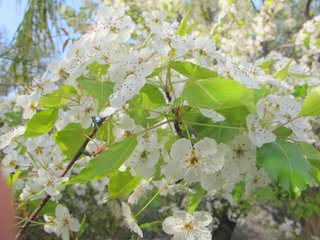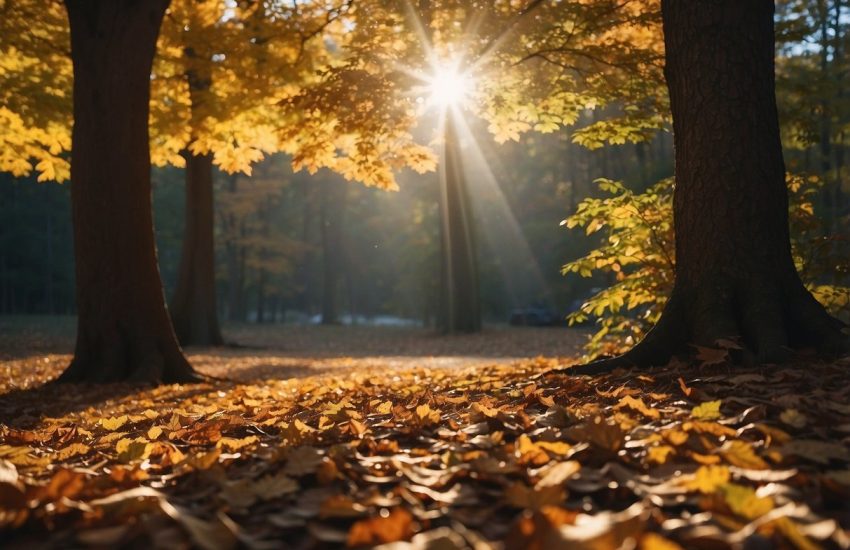The Best Ornamental Trees to Grow in Maryland
Ornamental plants are a vital addition to any garden, providing beauty and function. In addition to adding visual interest, ornamental plants can also provide valuable wildlife habitat. Many birds and insects rely on flowers for food, and shrubs and trees offer shelter from the elements. By incorporating a variety of ornamental plants into your garden, you can create a space that is not only beautiful but also supports local wildlife. In addition, many ornamental plants are also low-maintenance, making them a perfect choice for busy gardeners. With so many benefits, it’s easy to see why ornamental plants are essential to any garden. That said, ensuring that the selected plants are suitable for your location is important. Here are some ornamental plants suitable for any Maryland garden:
Green Hawthorn (Crataegus viridis)
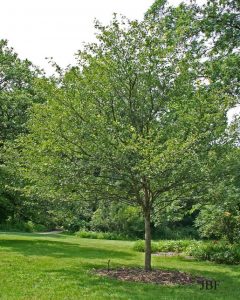
The Green Hawthorn (Crataegus viridis) is a small deciduous tree native to Europe and Asia. It is closely related to the common hawthorn (Crataegus monogyna) and shares many features, including its thorny branches and red fruits. However, the green hawthorn is distinguished by its glossy green leaves, which remain on the tree throughout the winter. These leaves provide an attractive contrast to the snow-covered landscape, making the green hawthorn a popular ornamental plant. The green hawthorn can grow to a height of 15m (49ft) and has a spread of 12m (39ft). The leaves are dark green, oval-shaped, and measure up to 5cm (2in) long. The flowers are small, white, and borne in clusters. They appear in early summer and are followed by red berries. The tree is also tolerant of cold weather and drought, making it an ideal choice for gardeners in colder climates. In addition, the green hawthorn is relatively disease-resistant, making it a low-maintenance plant that will thrive with minimal care.
American Sweetbay (Magnolia virginiana)
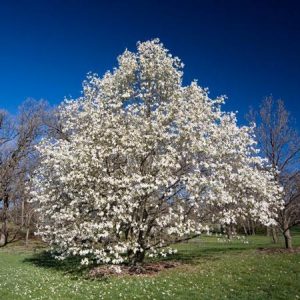
The North American Sweetbay (Magnolia virginiana) is a good ornamental plant for a range of settings. It is valued for its large, fragrant flowers that bloom in mid to late spring, its leathery evergreen leaves, and its dense, upright growth habit. Sweetbay magnolias are members of the Magnoliaceae family and are native to the eastern United States. They typically grow to be between 15-30 feet tall and wide, making them an excellent choice for use as a specimen plant or as part of a shrub border. Sweetbay magnolias are also relatively tolerant of urban pollution and salt spray, making them a good choice for planting near roads or in coastal areas. When selecting a sweetbay magnolia for your landscape, be sure to choose a variety that is well suited to the growing conditions in your area. Magnolia virginiana ‘Moonglow’ is a popular cultivar that is noted for its large, white flowers and glossy green leaves. For something slightly different, try the variegated leaf form known as ‘Green Drake.’
Shadblow (Amelanchier Canadensis)
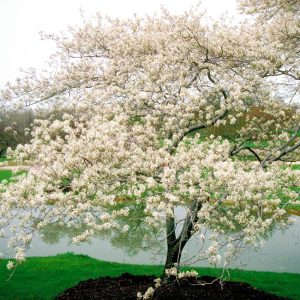
Shadblow (Amelanchier Canadensis) is a deciduous ornamental plant that is native to North America. It is a small tree or large shrub that typically grows to a height of 15-20 feet. The leaves are ovate or elliptical and have serrated margins. The flowers are white and borne in clusters. The fruit is a small, dark purple drupe. Shadblow is often used as an ornamental plant due to its attractive flowers and fruit. It is also popular for hedges and screens due to its dense growth habit. Additionally, Shadblow is tolerant of a wide range of soil conditions and is relatively resistant to pests and diseases.
Common Baldcypress (Taxodium distichum)
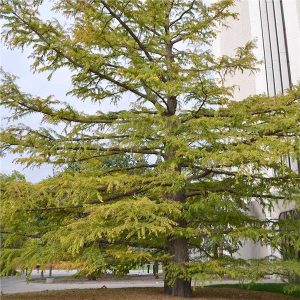
The Common Baldcypress (Taxodium distichum) is a large, deciduous tree that is native to the southeastern United States. The tree grows to a height of 60-100 feet and has a spread of 30-40 feet. The trunk is typically 2-3 feet in diameter and is often buttressed at the base. The bark is reddish-brown to grayish-brown and is deeply furrowed. The leaves are alternate, simple, and pinnately compound, with 20-40 leaflets per leaf. The flowers are small, greenish-yellow, and borne in dense clusters. The fruit is a cone-like structure that contains numerous seeds.
The Common Baldcypress is an excellent ornamental tree due to its changing foliage. The new leaves are bright green and small in spring before quickly growing larger and darker green over the summer months. In the fall, the leaves turn golden yellow before falling off the tree. The winter months provide a stunning contrast as the bare branches are covered with long, thin strands of Spanish moss. The tree also produces cones that mature in late summer and persist through winter. The Common Baldcypress is an excellent addition to any landscape due to its attractive foliage and cone production.
Hackberry (Celtis occidentalis)
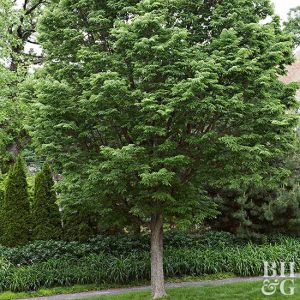
Hackberry (Celtis occidentalis) is a deciduous tree that is native to North America. It grows to a height of 50-75 feet and has a trunk diameter of 2-3 feet. The tree has a rounded crown and spreading branches. The leaves are ovate and 3-6 inches long. They are dark green and have a serrated margin. The tree produces small, greenish-white flowers in the spring, which are followed by dark purple berries. The berries are edible and are eaten by birds and other wildlife. Hackberry is a hardy tree that can grow in a variety of soil types and conditions. It is tolerant of drought, heat, and cold. Hackberry makes an excellent ornamental plant for the home landscape. It can be used as a specimen tree or planted in groups. The tree has interesting bark that ranges from smooth to corky. The fall foliage is yellow, orange, or red. Hackberry is also attractive to birds and provides food and shelter for them.
Honeylocust (Gleditsia triacanthos)
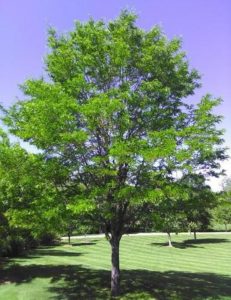
The Honeylocust (Gleditsia triacanthos) is a member of the pea family and is native to North America. It is a deciduous tree that loses its leaves in the fall. The Honeylocust can grow up to 50 feet tall, with a trunk diameter of up to 2 feet. The leaves are compound, and each leaf has 20-30 small leaflets. The flowers are small and green, and they appear in clusters in the spring. The fruit is a dark brown pod containing seeds that birds and other animals eat. The Honeylocust is a widely planted ornamental tree due to its attractive appearance and ability to thrive in various conditions. It is tolerant of drought and poor soil and resistant to pests and diseases. Furthermore, the Honeylocust produces very little litter, making it an ideal tree for use in urban environments.
Eastern White Pine (Pinus strobus)
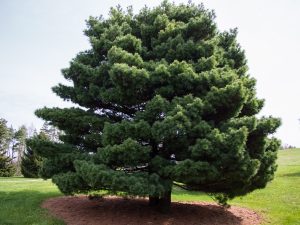
The Eastern white pine (Pinus strobus) is a large evergreen tree that is native to the northeastern United States and southeastern Canada. It can grow up to 80 feet tall and has a pyramidal shape with long, slender branches. The tree’s needles are 2-5 inches long and occur in clusters of 5. The green needles turn yellow-brown in the fall before they are shed. The Eastern white pine produces cones that are 3-6 inches long and have thin scales. The cones turn brown when they mature and release their seeds in the fall. The Eastern white pine is a popular landscaping plant because of its attractive appearance and ability to tolerate a variety of growing conditions. It prefers full sun but can also grow in partial shade. It is tolerant of urban pollution and salt spray, making it an ideal choice for street trees. The Eastern white pine is also resistant to ice, wind, and snow damage. This makes it a good choice for planting in areas where severe weather conditions are common.
Pin Oak (Quercus palustris)
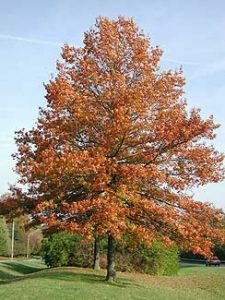
The Pin Oak (Quercus palustris) is a medium-sized deciduous tree native to North America. It typically grows to a height of 50-60 feet and has a spread of 30-40 feet. When young, the Pin Oak has a pyramidal shape but develops into a round or oval crown as it matures. The bark is light gray and smooth, with occasional dark streaks. The leaves are simple, alternate, and 5-9 inches long. They are shiny green above and pale green below, with deeply lobed margins. The flowers are small and greenish-yellow, blooming in May or June. The fruit is a small acorn, about 1/2 inch in diameter, with a glossy brown cupule. Pin Oak is commonly used as a landscaping plant because of its attractive form and foliage. It is also tolerant of pollution and drought, making it well-suited for urban environments. Additionally, the Pin Oak provides valuable food and shelter for wildlife.
Southern Arrowwood (Viburnum dentatum)
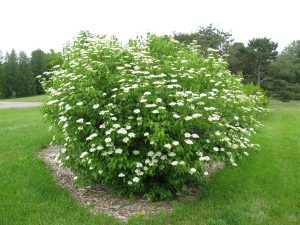
The Southern arrowwood (Viburnum dentatum) is native to eastern North America, where it is often found in open woodlands, along streams, and moist, sandy soils. It is a deciduous shrub that typically grows 10-15 feet tall and wide, with a rounded habit. The leaves are oval-shaped, 3-6 inches long, and have sharply toothed margins. In fall, the leaves turn a deep red or purple color. The flowers are small and white, borne in late spring or early summer clusters. The fruits are green maturing to blue or black, and are attractive to birds. Southern arrowwood is a hardy plant that is relatively easy to care for. It can be used as an ornamental shrub in various landscape settings. It is tolerant of full sun or part shade and prefers moist soils. It can be pruned to maintain a smaller size if desired.
Allegheny Serviceberry (Amelanchier laevis)

The Allegheny Serviceberry (Amelanchier laevis) is a deciduous shrub or small tree that is native to North America. It is a member of the Rosaceae family, and its scientific name comes from the Greek word for serviceberry, Amelanchier. The Allegheny serviceberry is a popular ornamental plant and is often used in landscape design. This plant is characterized by its white flowers, which appear in early spring, and its purple-black fruit, which ripens in late summer. The Allegheny serviceberry can grow to be 15 feet tall and 10 feet wide, and it prefers full sun to partial shade. This plant is relatively easy to care for and is drought-tolerant, making it a good choice for low-maintenance gardens. The Allegheny serviceberry is an attractive plant that provides food and shelter for wildlife. It is also a good choice for erosion control due to its deep roots.
Eastern Redbud (Cercis canadensis)
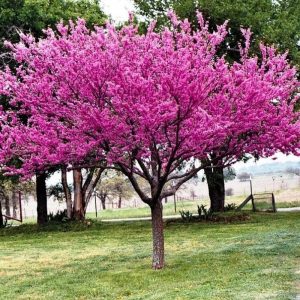
The Eastern redbud (Cercis canadensis) is a small deciduous tree native to the eastern United States and Canada. It typically grows to 15-30 feet and has a spreading, rounded crown. The trees are often used for landscaping purposes due to their attractive fall foliage. The flowers are small and pink, appearing in clusters on the branches in early spring. The leaves are heart-shaped and dark green, turning yellow, orange, or red in the fall. Eastern redbuds are relatively easy to care for, and overseeding is unnecessary. However, they do require full sun to partial shade and well-drained soil. If you live in an area with harsh winters, it is important to choose a cold and hardy variety. Eastern redbuds are generally pest and disease-resistant, making them a low-maintenance option for your landscape.

